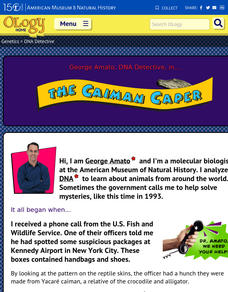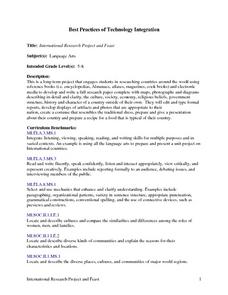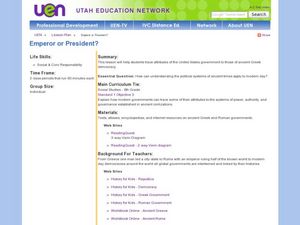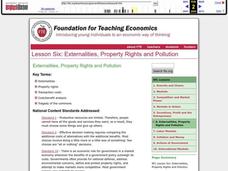Virginia Department of Education
A Crystal Lab
Young chemists grow ionic crystals, metallic crystals, and supersaturated crystals in three different lab experiments. Observing these under a microscope allows pupils to compare the various structures.
Curated OER
Imposing Democracy
Twelfth graders discuss the probability of imposing a democracy in a country in which there is no history of this type of government being successful. Using the internet, they work together to research Japan's experience with democracy...
Curated OER
The Art of Protesting
Students view various images to examine different types of protest Americans have used throughout history, and explore ways in which protest can produce change for better or worse.
Curated OER
Latin America and United States Policy Today
Young scholars compare the situation of Latin American immigrants with the situation of immigrants from other areas of the world. They use media to obtain information on topics of academic interest, personal interest, and intellectual...
Curated OER
Purposes of Dating
So many options are included here for you to help your class explore dating, relationships, and types of love. These lessons are becoming more and more important due to media influences, so choose one of the 10 options to guide your...
Curated OER
Not Getting the News about the Stamp Act
How did American colonists react to the Stamp Act of 1765? Your young historians will examine primary source material by reading excerpts from a transcription of the Pennsylvania Gazette and then identifying the sentiments expressed by...
Curated OER
Video Game Violence: Explore Possible Impacts
Introduce middle schoolers to the issue of video game violence with a multifaceted approach. Learners complete a gaming survey, as well as read and discuss a news feature about violent video game sales and a handout on stimulus...
American Museum of Natural History
DNA Detective
Match up the DNA code. Pupils read the website from the American Museum of Natural History about how DNA can determine whether a skin is from a particular type of reptile. Using the same technique, learners match up products with the...
Curated OER
George Washington and the Rule of Law
students compare The rule of law with the rule of men and consider life under each of these types of governments.In this government lesson, students read a primary source to examine the importance of the rule of law.They will also answer...
Curated OER
International Research Project and Feast
Pupils research countries around the world. They develop and write a research paper that includes maps, photographs, and diagrams. They describe the culture, society, economy, religious beliefs, government structure, and history of their...
Curated OER
The Need for Laws
Students consider the presence of authority in their lives. In this law lesson plan, students compare forgotten laws that function in their lives to forgotten instructions in making a peanut butter and jelly sandwich.
Curated OER
Types of Societies
Young scholars compare and contrast the societies of India and the United States by creating a chart. In groups, they give examples of each type of classification. They present their material to the class while identifying the role of...
Curated OER
Comparing Apples and Oranges
Fifth graders, in groups, examine different types of apples and how they are different. They also taste the differences of each apple. They use this lesson to explore how to make observations.
Curated OER
Emperor or President?
Sixth graders complete a Venn Diagram. In this government comparison lesson plan, 6th graders discuss how rules are similar and different at home, school and in their community. Students learn about the type and structure of the United...
Curated OER
Where Do You Live?
Second graders study and compare rural, suburban, and urban communities. They play a board game, read books about communities, and complete several other activities regarding the different types of communities. Several extension and...
Curated OER
Externalities, Property Rights and Pollution
Learners identify the various externalities for any type of production. Using that information, they examine situations in which they are positive and negative. They discuss government efforts to protect the environment and humans. In...
Curated OER
A Tale of Two Wetlands
Students observe 2 separate wetlands (following downloadable worksheets) and record 10 similarities and 10 differences between them. Then they present their recommendations to the class who roleplay the government's wetland conservation...
Curated OER
Radio Program #5: Moonshining
Students interpret the conditions that surrounded the "moonshining industry" in southeastern Ohio. Interview people who may have been influenced by some experience with someone involved in this type of industry. Prohibition laws are...
Curated OER
We the Past
Students study philanthropy related terms and philanthropy in the United States and their local community. In this philanthropy instructional activity, students study pictures of present and past Americans and discuss their philanthropic...
Curated OER
Comparing the Confessional traditions that Emerge from the Reformation
Ninth graders examine the Protestant Reformation. In this World History activity, 9th graders research various places of worship. Students comapre and contrast the different sects of religion that resulted from the Protestant...
Curated OER
Taxes
Students use the internet to examine the various types of taxes. Using this information, they develop a chart comparing and contrasting the types and determinations of how much tax needs to be paid. They share their charts with the...
Curated OER
The Role of Question Period in the Legislative Process
Learners research the roles of key positions in the Canadian government by watching an episode of Question Period and refering to various examples of news media from the day following the Question Period.
Curated OER
Federal Programs And Reform
Students investigate the current welfare system in Utah. They research and discuss the different type of programs that are offered. They conduct an analysis of the reports that are provided. The standard of living is also investigated...
Curated OER
Fossil Formation Fun
Students compare the three types of fossils: preserved organisms, mineral replacement fossils, and impression fossils. They create a model of amber,
sponge fossil, and make traces of fossil.

























